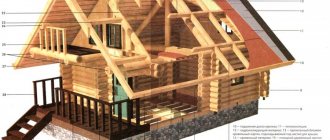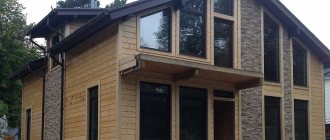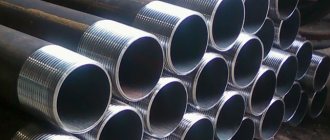23.09.2014
Building houses on screw piles has become a good opportunity to save time and money for many future homeowners. But for some regions of Russia, this is also an opportunity to get a high-quality house that will not collapse or float away due to the vagaries of nature.
Builders jokingly note that it was the Russians who were the first to come up with pile construction - it’s worth remembering the famous hut on chicken legs.
Screw piles have become a new stage in construction in permafrost areas
How to properly build a house on the water
To build a floating house (houseboat), the same technologies and materials are used as for building a regular house. The key difference is that the base of a house on a solid surface is a foundation, while the base of a houseboat is a pontoon.
The first thing that needs to be done before starting construction of any type of house, including a floating one, is to draw up a project for the future structure. The design must take into account the maximum permissible load, weight and characteristics of the building materials used. It is also necessary to take into account external factors: maximum wave height and wind speed in the water area selected for construction, and current speed.
The optimal location for a house on the water is an internal reservoir (pond, lake) with standing water, a wave height of no more than 1 meter and a maximum wind speed of no more than 15 meters per second. The owner needs to remember that even with slight fluctuations in the water surface, people prone to seasickness will feel discomfort. This will not allow them to live in such a house on a permanent basis.
According to the Water Code of the Russian Federation, the lease of a section of a lake, river or reservoir is carried out on the basis of a water use agreement. The transfer of water bodies to private ownership is not allowed - they are all federal property. An exception is a pond or quarry within the boundaries of a land plot that is private property.
All houses on the water are classified as small floating objects. Before construction begins, the house design must be agreed upon with the State Inspectorate for Small Vessels (GIMS), which is under the jurisdiction of the Russian Ministry of Emergency Situations. After completion of construction, a house on the water is subject to mandatory state registration.
Fight for survival
Gradual and inevitable immersion in water is a serious, pressing problem that Venetians have had to contend with since the very beginning of the city's founding. Because of this, the city was rebuilt twice as people created new housing on the higher islands. However, only in the last century Venice sank another 23 cm under water. Such rates of flooding carry enormous risks - local residents do not risk building new houses.
Previous articles
Celebrating Christmas in ItalyIn this article we will talk about how to celebrate Christmas in Italy, what you should pay attention to during the preparation process. ... |
Construction on water: determining the purpose of the structure
In what capacity to use the house on the water, its owner decides based on his goals, preferences and financial capabilities. The result of construction on the water can be a full-fledged house, a summer cottage for seasonal living, or a fisherman’s house for recreation and fishing in nature. It is possible to use a floating house for commercial purposes - as a mini hotel, guest house, bath and sauna complex.
Based on the purpose of use, the total area of the structure, the number of rooms and their purpose are determined. If the owner allows for the possibility of transportation by water, then the base of the house should be a pontoon made of metal or plastic. In the case of a permanent installation of the house, the base will be a standard foundation.
Landing stage design. Its main principles and stages
To create a reliable, durable and safe structure, it is necessary to approach the design of a “floating” house with all responsibility. In order to avoid mistakes and accidents during the construction and operation of such a building, only good specialists in this field of construction who have mandatory certificates and licenses must be involved in such work. It is also advisable to use the experience of local river shipping workers.
The creation of a residential building project on the water should be done in stages:
1. Preliminary calculation of the load-carrying capacity of the base of the future building, selection of suitable material and design, and final calculations for the strength and stability of all elements of the pontoon.
2. Based on the calculated data obtained at the first stage, it is necessary to design the structure of the house, select the material for construction based on its mechanical characteristics: it must be sufficiently strong and rigid with a relatively small weight.
3. Next, it is necessary to think over and provide for the placement of all city communications, such as:
- plumbing system;
- electrical network;
- efficient heating system;
- safe water drainage and sewerage system.
4. The stage of ensuring safe living for people will finally complete the project of the house on the water. It is also necessary to take into account the possibilities for safe navigation.
It is important to carefully calculate the stability of the surface structure so that the house does not tilt or sway during strong winds.
Not only the comfort of living in the future home, but also its durability, reliability and safety will depend on how accurately and in detail the design of the landing stage is developed. Therefore, it is important to find a responsible professional in this matter.
Return to content
Preparing a house on the water project
To create a safe, durable and reliable house that can serve its owners for a long time, you need a competent and correctly drawn up project that includes all stages of building a house on the water. In the absence of education in the field of architecture and engineering systems, it is better to entrust the development of the project to professionals - they can be found in river navigation.
What is included in the houseboat project:
- selection of materials for construction,
- calculation of the base/foundation taking into account load capacity,
- engineering project,
- description of the safety conditions of the building, taking into account its features.
See also photos of houses on a cliff above the sea.
Project
The project is a very important point in construction. It is necessary to correctly carry out all preliminary calculations regarding the size and load-carrying capacity of the structure, since the house must be a safe home for the people living and in no case be an obstacle to ships and other floating craft. In addition to the architect, a specialist from the Shipping Department should be involved in the development of the project, since it is this Department that strictly controls the construction process of the landing stage.
Communications and foundation
If you have designed the pontoon and the building itself, you must resolve the issue of communications.
What needs to be carried into the house:
- sewerage,
- water pipes,
- electricity,
- heating.
Sometimes it is possible to connect to city communications, but this is not always the case.
If the location of your home precludes such a connection, the best option is to purchase autonomous systems. Stock up on tanks for fuel, water and waste water. The most difficult thing to solve is the heating issue - you can’t connect to the city system, and there are three ways left
- Install a boiler for heating (there are many models that operate on different types of fuel.)
- Choose electric heating - but you need to be prepared for hefty electricity bills.
- Installing vacuum solar collectors is convenient, but also quite expensive.
You can also install cast iron fireplace stoves or create a “warm floor” - but this again entails significant electricity costs.
If the house is located within the city, it is usually easy to connect it to the city power grid. If not, autonomous power supply systems remain: solar panels, diesel or wind generators. Their installation is an environmentally friendly, but not a cheap solution. To illuminate a houseboat and keep household appliances running, you will need 100 kW of power. There is no point in paying for more powerful devices.
It is necessary to establish a water supply in the house - not only technical, but also clean drinking water is needed. As with electricity, the easiest option is to connect to the city water supply. If this is not possible, all that remains is to drill a well in the vicinity of the house on the shore. To do this legally, you need paper from the Environmental Protection Agency. Water purification plants and high-quality filters will help turn process water into drinking water.
Another important point is the sewerage and drainage system. The simplest and cheapest option is a sewer collector on land, but it is not always possible to connect to it. An alternative is a wastewater tank or an autonomous sewage system where wastewater undergoes a biological treatment procedure. True, this is not a cheap solution. The main advantage is environmental friendliness, since the water undergoes complete purification.
So, you have resolved the issue of infrastructure and communications. But when building any house, you first need to tackle the foundation. There is a nuance here - a floating house does not have a foundation in the usual sense of the word. Instead, there is a platform like a raft, the so-called pontoon. Since it must withstand the load of a full-fledged structure, it must be a very reliable and durable platform. The designs and materials for its construction are different - you can make it from plastic or steel, reinforced concrete or wood. Plastic is used for small and light buildings such as gazebos on the water, and other materials can be used for a full-fledged house.
But if we are talking about a house on the water, and not a floating house, then a regular foundation is poured: approximately the same as for swampy soil. Often, screw piles and other methods of constructing structures in swampy areas are used for this.
Communications on a houseboat
Regardless of the type of residential building or its location, it is necessary to ensure decent living conditions in it. If the floating structure is located within the boundaries of the settlement, located near the shore, it is possible to connect to centralized sewerage and water supply lines. Comfort in the house can be ensured even in the absence of coastal systems.
There is a lot of equipment available on the modern market for arranging autonomous communications. The house may have:
- reservoirs with a supply of drinking water
- fuel containers
- electric generators
- septic tanks for collecting waste water
Household comfort can be ensured even in the absence of city communications
Installation of such systems will provide proper living conditions. There is no need to create water reserves for domestic needs.
A house for permanent residence must be equipped with heating systems. Steel or cast iron fireplace stoves will help maintain a comfortable temperature. You can install a system of gas and electric convectors. It is advisable to equip infrared or electric “warm floors” in such buildings
The fireplace stove will help maintain a comfortable temperature
Houses on the water: construction technology
So, with the exception of the peculiarities of the foundation (which can be a pontoon) and communications for a house on the water, the rest of its construction technology is not too different from stationary houses.
You need to choose a place without strong currents and rough waters. A quiet pond or lake with waves up to a meter in size is best. The site should not be too windy (maximum wind speed up to 15 m/s)
First, they make a pontoon - steel or reinforced concrete structures are best suited for it. It is important to stick to the existing project.
The easiest and fastest option is to make houses from factory block containers. They can be made to order. If this is a floating house, all that remains is to make a pontoon and then attach the blocks to it. Don't forget to distribute the load evenly around the perimeter.
The frame of the house is made of steel using welding. This is important because of the unstable position of the house - no matter how quiet the body of water is, water disturbances cannot be avoided. The steel frame design avoids distortions of the building.
For the same purpose, the house is finished with cladding panels. Usually they do without putty and plaster to avoid the appearance of cracks in case of strong waves of the reservoir.
It is very important to properly seal communications - taking into account high humidity.
To prevent puddles from appearing on the floor of the house during rain and snow, it is better to install door closers so that all doors and windows close automatically.
A wooden house needs to be treated with an antiseptic and fire retardant. In addition to durability, this will ensure fire safety for the building.
It is possible to build a house of high quality, you can live in it all year round, even in severe frosts. The main thing is to insulate the structure well. You can also install a sauna there.
As for the choice of builders, it is better to attract professionals from construction companies who already have experience with houses on the water.
Tips and nuances
- Regarding documents, you need to obtain a certificate of ownership, then the house must undergo an inspection; after this it can be put into operation. Each house on the water is assigned a number, and the owner must have permission to moor. It's a good idea to insure your home. Please note that you cannot register in such a building - after all, it is officially registered as a floating craft.
- It is important to provide your house on the water with water rescue equipment (rubber boat, lifebuoys and vests) and fire extinguishers.
- If you do not live there permanently, but only use it periodically, you can rent a country diesel generator.
- In addition, the house will need an anchor or similar device that prevents it from moving freely through the water. A large plastic container filled with earth and sand can serve as a kind of “anchor”. Usually houses on the water drift near the shore near the suspension bridge, and the anchor prevents them from floating freely.
The construction of a house on the water has its own characteristics, mainly related to the construction of a pontoon and the installation of communications, as well as the preparation of documents. A well-insulated and equipped houseboat can become a full-fledged home for a whole year, but you cannot register there, since it is officially a floating craft. More often, such a structure is used as a temporary shelter, a summer cottage on the water, or a fishing lodge.
Types of buildings and their design features
Buildings for entertainment purposes are usually built on the water: nightclubs, mini-hotels, holiday homes and others. There is a tendency to build residential buildings, they will differ in type:
- year-round or seasonal;
- mobile or landline;
- placement outside the boundaries of a populated area and inside it;
- location on a ship's foundation, pontoon or piles.
Most often, they try to exploit this kind of buildings for summer recreation. They have proven themselves to be excellent dachas and country houses where you can spend your holidays and relax in nature.
Design version of a floating house Source doverie-omsk.ru
Popular bases for floating houses are pontoons. They are stronger and allow you to choose the type of construction. For example, stationary buildings are fixed strictly to a specific location. It is possible to design a mobile version of the home. It differs in that it can be transported using a special tug or a mechanism provided by the design. Pontoons are considered a reliable structure that will last a long time even in a humid environment.
Transportable floating house Source mrrestavrator.ru
On a note! There are options for floating houses that can be reached via a specially equipped bridge, and there are models to which the path lies across the entire river or lake. That is, you can only get there by water transport.











